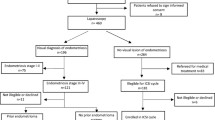Abstract
Purpose: To evaluate the antral follicle (AF) counting in predicting the outcome after controlled ovarian hyperstimulation (COH) and IVF-ET.
Methods: Infertile women who accepted the COH and IVF-ET were included prospectively. Day-3 AF number was determined by transvaginal sonography. They were divided into three groups: Group 1: ≤3 AF; Group 2: 4–10 AF; Group 3: ≥11 AF. Retrieval oocyte number, embryo number, pregnancy rate (PR), and implantation rate (IR) of the three groups were compared.
Results: A total of 372 cycles were included. Patients in Groups 1, 2, and 3 were statistically different in age (35.3 vs. 31.9 vs. 28.5), Day-3 FSH (14.3 vs. 5.9 vs. 4.1), cancellation (34.4% vs. 2.7% vs. 0.9%), gonadotropin dosage, retrieval oocyte number (2.9 vs. 8.2 vs. 14.5), embryo number (2.2 vs. 6.5 vs. 11.7), PR (11.1% vs. 34.6% vs. 35.0%), and IR (3.0% vs. 8.2% vs. 8.9%).
Conclusions: Patients with ≤3 AF have a significantly higher cancellation rate, fewer retrieved oocyte number, and lower PR. Combination of AF counting and basal FSH level increased the sensitivity in predicting the ovarian reserve. Retrieved oocyte number could be predicted by the formula: oocyte = 0.802 × AF + 2.01.
Similar content being viewed by others
REFERENCES
Toner JP, Philput CB, Hones GS, Muasher SJ: Basal follicle-stimulating hormone level is a better predictor of in vitro fertilization performance than age. Fertil Steril 1991;55:784-791
Templeton A, Moris JK, Parslow W: Factors that affect outcome of in-vitro fertilization treatment. Lancet 1996;348:1402-1406
Hansen LM, Batzer FR, Gutmann JN, Corson SL, Kelly MP, Gocial B: Evaluating ovarian reserve: follicle stimulating hormone and oestradiol variability during cycle day 2-5. Hum Reprod 1996;11:486-489
Scott RT Jr, Hofmann GE: Prognostic assessment of ovarian reserve. Fertil Steril 1995;63:1-11
Wallach EE: Pitfalls in evaluating ovarian reserve. Fertil Steril 1995;63:12-14
Chang MY, Chiang CH, Hsieh TT, Soong YK, Hsu KH: Use of the antral follicle count to predict the outcome of assisted reproductive technologies. Fertil Steril 1998;69:505-510
Chang MY, Chiang CH, Hsieh TT, Soong YK, Hsu KH: The influence of endometriosis on the success of gamete intrafalopian transfer. J Assist Reprod Genet 1997;14:76-82
Hsieh YY, Tsai HD, Chang CC, Chang CC, Lo HY: Comparison of single half-dose, long-acting form of GnRHa and short-acting form of GnRHa in pituitary suppression in controlled ovarian hyperstimulation programme. Fertil Steril 2000;73:817-820
Hsieh YY, Tsai HD, Chang CC, Chang CC, Lo HY, Lai AC: Ultrarapid cryopreservation of human embryos: experience with 1,582 embryos. Fertil Steril 1999;72:253-256
Syrop CH, Dawson JD, Husman KJ, Sparks AE, Van Voorhis BJ: Ovarian volume may predict assisted reproductive outcomes better than follicle stimulating hormone concentration on day 3. Hum Reprod 1999;14:1752-1756
Fabregues F, Balasch J, Creus M, Carmona F, Puerto B, Quinto L, Casamitjana R, Vanrell JA: Ovarian reserve test with human menopausal gonadotropin as a predictor of in vitro fertilization outcome. J Assist Reprod Genet 2000;17:13-19
Engmann L, Sladkevicius P, Agrawal R, Bekir JS, Campbell S, Tan SL: Value of ovarian stromal blood flow velocity measurement after pituitary suppression in the prediction of ovarian responsiveness and outcome of in vitro fertilization treatment. Fertil Steril 1999;71:22-29
Pellicer A, Ardiles G, Neuspiller F, Remohi J, Simon C, Bonilla-Musoles F: Evaluation of the ovarian reserve in young low responders with normal basal levels of follicle-stimulating hormone using three-dimensional ultrasonography. Fertil Steril 1998;70:671-675
Tsai HD, Chang CC, Hsieh YY, Lee CC, Lo HY: Artificial insemination. Role of endometrial thickness and pattern, of vascular impedance of the spiral and uterine arteries, and of the dominant follicle. J Reprod Med 2000;45:195-200
Sharara FI, Mcclamrock HD: The effect of aging on ovarian volume measurements in infertile women. Obstet Gynecol 1999;94:57-60
Toth TL, Hodgen GD: Ovarian follicular growth and maturation. In Reproductive medicine and surgery, EE Vallach, HA Zacur (eds), St Louis, CV Mosby, 1995, pp. 137-157
Gosden R, Spears N. Programmed cell death in the reproductive system. Br Med Bull 1997;53:644-661
Scheffer GJ, Broekmans FJM, Dorland M, Habbema JDF, Looman CWN, Velde ER. Antral follicle counts by transvagial ultrasonography are related wto age in women with proven natural fertility. Fertil Steril 1999;72:845-851
Author information
Authors and Affiliations
Rights and permissions
About this article
Cite this article
Hsieh, YY., Chang, CC. & Tsai, HD. Clinical Assisted Reproduction: Antral Follicle Counting in Predicting the Retrieved Oocyte Number After Ovarian Hyperstimulation. J Assist Reprod Genet 18, 320–324 (2001). https://doi.org/10.1023/A:1016688806431
Issue Date:
DOI: https://doi.org/10.1023/A:1016688806431




